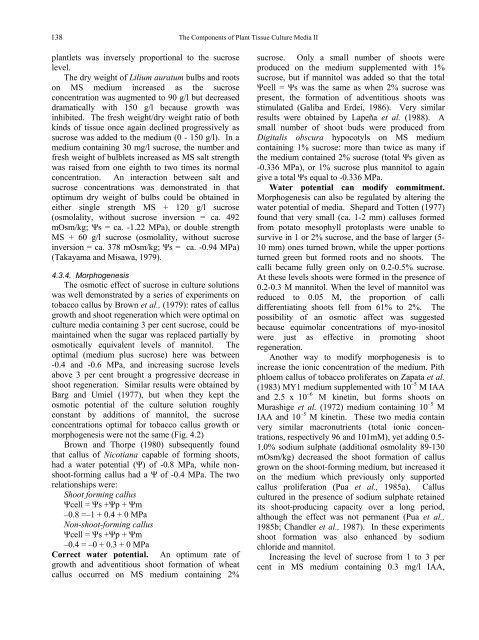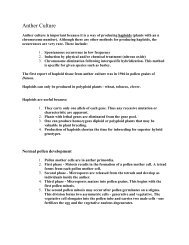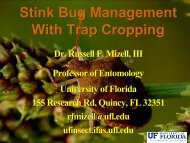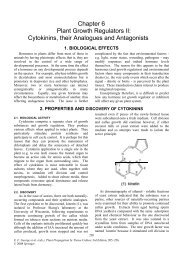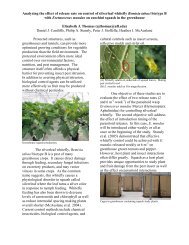The Components of Plant Tissue Culture Media II - Horticultural ...
The Components of Plant Tissue Culture Media II - Horticultural ...
The Components of Plant Tissue Culture Media II - Horticultural ...
You also want an ePaper? Increase the reach of your titles
YUMPU automatically turns print PDFs into web optimized ePapers that Google loves.
138 <strong>The</strong> <strong>Components</strong> <strong>of</strong> <strong>Plant</strong> <strong>Tissue</strong> <strong>Culture</strong> <strong>Media</strong> <strong>II</strong><br />
plantlets was inversely proportional to the sucrose<br />
level.<br />
<strong>The</strong> dry weight <strong>of</strong> Lilium auratum bulbs and roots<br />
on MS medium increased as the sucrose<br />
concentration was augmented to 90 g/l but decreased<br />
dramatically with 150 g/l because growth was<br />
inhibited. <strong>The</strong> fresh weight/dry weight ratio <strong>of</strong> both<br />
kinds <strong>of</strong> tissue once again declined progressively as<br />
sucrose was added to the medium (0 - 150 g/l). In a<br />
medium containing 30 mg/l sucrose, the number and<br />
fresh weight <strong>of</strong> bulblets increased as MS salt strength<br />
was raised from one eighth to two times its normal<br />
concentration. An interaction between salt and<br />
sucrose concentrations was demonstrated in that<br />
optimum dry weight <strong>of</strong> bulbs could be obtained in<br />
either single strength MS + 120 g/l sucrose<br />
(osmolality, without sucrose inversion = ca. 492<br />
mOsm/kg; Ψs = ca. -1.22 MPa), or double strength<br />
MS + 60 g/l sucrose (osmolality, without sucrose<br />
inversion = ca. 378 mOsm/kg; Ψs = ca. -0.94 MPa)<br />
(Takayama and Misawa, 1979).<br />
4.3.4. Morphogenesis<br />
<strong>The</strong> osmotic effect <strong>of</strong> sucrose in culture solutions<br />
was well demonstrated by a series <strong>of</strong> experiments on<br />
tobacco callus by Brown et al., (1979): rates <strong>of</strong> callus<br />
growth and shoot regeneration which were optimal on<br />
culture media containing 3 per cent sucrose, could be<br />
maintained when the sugar was replaced partially by<br />
osmotically equivalent levels <strong>of</strong> mannitol. <strong>The</strong><br />
optimal (medium plus sucrose) here was between<br />
-0.4 and -0.6 MPa, and increasing sucrose levels<br />
above 3 per cent brought a progressive decrease in<br />
shoot regeneration. Similar results were obtained by<br />
Barg and Umiel (1977), but when they kept the<br />
osmotic potential <strong>of</strong> the culture solution roughly<br />
constant by additions <strong>of</strong> mannitol, the sucrose<br />
concentrations optimal for tobacco callus growth or<br />
morphogenesis were not the same (Fig. 4.2)<br />
Brown and Thorpe (1980) subsequently found<br />
that callus <strong>of</strong> Nicotiana capable <strong>of</strong> forming shoots,<br />
had a water potential (Ψ) <strong>of</strong> -0.8 MPa, while nonshoot-forming<br />
callus had a Ψ <strong>of</strong> -0.4 MPa. <strong>The</strong> two<br />
relationships were:<br />
Shoot forming callus<br />
Ψcell = Ψs +Ψp + Ψm<br />
–0.8 =–1 + 0.4 + 0 MPa<br />
Non-shoot-forming callus<br />
Ψcell = Ψs +Ψp + Ψm<br />
–0.4 = –0 + 0.3 + 0 MPa<br />
Correct water potential. An optimum rate <strong>of</strong><br />
growth and adventitious shoot formation <strong>of</strong> wheat<br />
callus occurred on MS medium containing 2%<br />
sucrose. Only a small number <strong>of</strong> shoots were<br />
produced on the medium supplemented with 1%<br />
sucrose, but if mannitol was added so that the total<br />
Ψcell = Ψs was the same as when 2% sucrose was<br />
present, the formation <strong>of</strong> adventitious shoots was<br />
stimulated (Galiba and Erdei, 1986). Very similar<br />
results were obtained by Lapeña et al. (1988). A<br />
small number <strong>of</strong> shoot buds were produced from<br />
Digitalis obscura hypocotyls on MS medium<br />
containing 1% sucrose: more than twice as many if<br />
the medium contained 2% sucrose (total Ψs given as<br />
-0.336 MPa), or 1% sucrose plus mannitol to again<br />
give a total Ψs equal to -0.336 MPa.<br />
Water potential can modify commitment.<br />
Morphogenesis can also be regulated by altering the<br />
water potential <strong>of</strong> media. Shepard and Totten (1977)<br />
found that very small (ca. 1-2 mm) calluses formed<br />
from potato mesophyll protoplasts were unable to<br />
survive in 1 or 2% sucrose, and the base <strong>of</strong> larger (5-<br />
10 mm) ones turned brown, while the upper portions<br />
turned green but formed roots and no shoots. <strong>The</strong><br />
calli became fully green only on 0.2-0.5% sucrose.<br />
At these levels shoots were formed in the presence <strong>of</strong><br />
0.2-0.3 M mannitol. When the level <strong>of</strong> mannitol was<br />
reduced to 0.05 M, the proportion <strong>of</strong> calli<br />
differentiating shoots fell from 61% to 2%. <strong>The</strong><br />
possibility <strong>of</strong> an osmotic affect was suggested<br />
because equimolar concentrations <strong>of</strong> myo-inositol<br />
were just as effective in promoting shoot<br />
regeneration.<br />
Another way to modify morphogenesis is to<br />
increase the ionic concentration <strong>of</strong> the medium. Pith<br />
phloem callus <strong>of</strong> tobacco proliferates on Zapata et al.<br />
(1983) MY1 medium supplemented with 10 –5 M IAA<br />
and 2.5 x 10 –6 M kinetin, but forms shoots on<br />
Murashige et al. (1972) medium containing 10 –5 M<br />
IAA and 10 –5 M kinetin. <strong>The</strong>se two media contain<br />
very similar macronutrients (total ionic concentrations,<br />
respectively 96 and 101mM), yet adding 0.5-<br />
1.0% sodium sulphate (additional osmolality 89-130<br />
mOsm/kg) decreased the shoot formation <strong>of</strong> callus<br />
grown on the shoot-forming medium, but increased it<br />
on the medium which previously only supported<br />
callus proliferation (Pua et al., 1985a). Callus<br />
cultured in the presence <strong>of</strong> sodium sulphate retained<br />
its shoot-producing capacity over a long period,<br />
although the effect was not permanent (Pua et al.,<br />
1985b; Chandler et al., 1987). In these experiments<br />
shoot formation was also enhanced by sodium<br />
chloride and mannitol.<br />
Increasing the level <strong>of</strong> sucrose from 1 to 3 per<br />
cent in MS medium containing 0.3 mg/l IAA,


